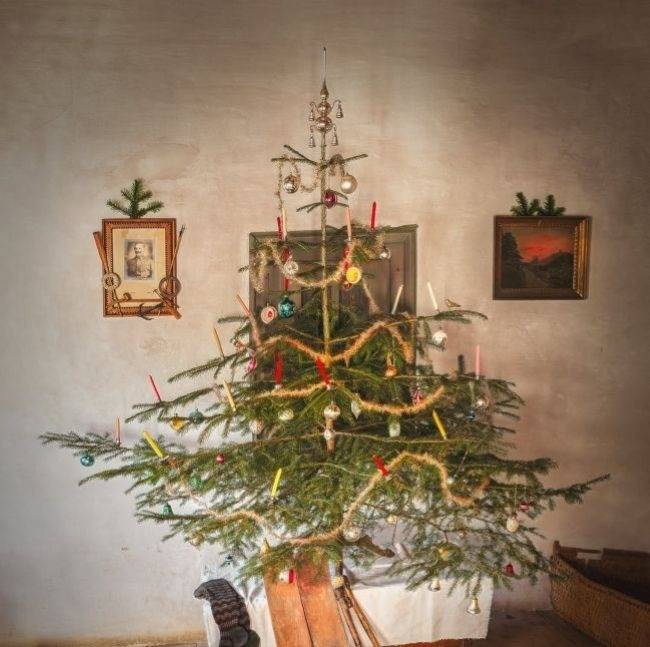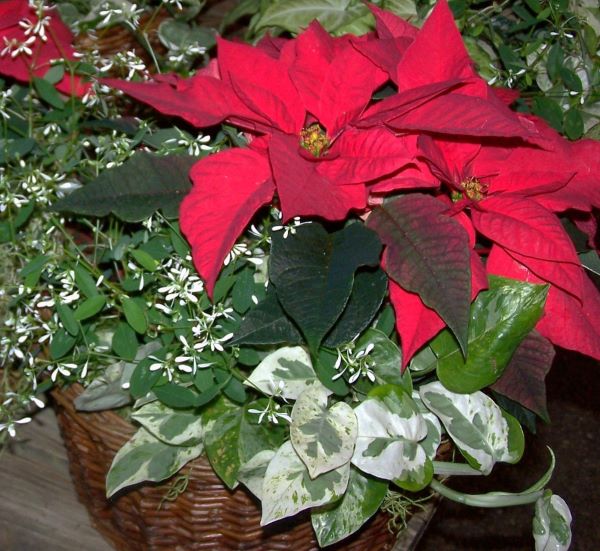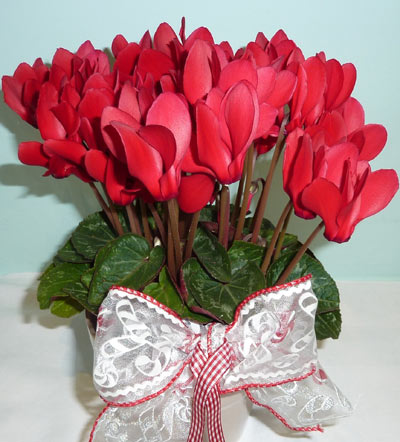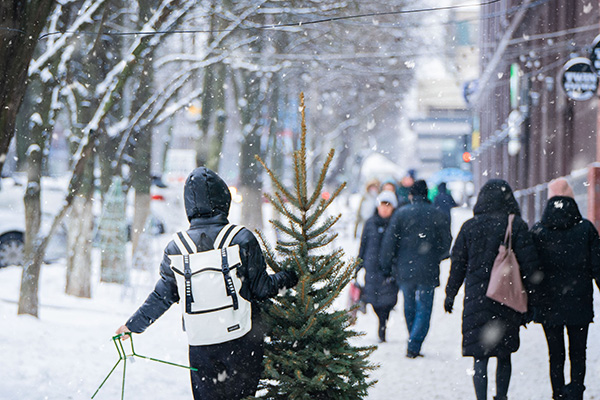The Christmas Tree, a centuries old holiday tradition, has certainly seen some changes in modern times. From Germany in the 1500s, the evergreen hung with ornaments of fruits, nuts, and sweets remained virtually unchanged through the early 20th century. The 1930s saw the first boom in artificial trees, but post WWII the materials and styles expanded. Today, we can choose from life-like artificial trees or fanciful trees in every color of the rainbow—with fake snow, and/or prelit, if you desire. Meanwhile, the good old evergreen Christmas Tree is perhaps facing a crisis as its producers are growing older and retiring, without sufficient interest from younger generations in continuing the tradition.

Christmas Trees: From Germany to Britain, then the world!
The first decorated Christmas trees are said to have originated around the beginning of the 17th century in Germany. Apples were one of the first ornaments, representing the forbidden fruit on what were called “Paradise Trees.” Martin Luther is often credited with first adding candles to the trees, attempting to recreate the wonder of stars shining through the tree limbs, but this may be more legend than fact. Tinsel was made from actual silver in Germany during this time as well. Other common decorations included dried fruits, berries, nuts, small pastries, and later homemade ornaments of paper, tin, fabric, and straw in shapes of flowers, hearts, angels or stars.
In the late 1700s, Queen Charlotte, wife of King George III, brought her Germanic tradition of Christmas trees to Britain, although it would be many more decades before the idea gained wide popularity. Palace trees were placed on tables and hung with edible ornaments, small gifts, and slim candles. The candles would be lit for a brief celebration while the children opened their presents on Christmas Eve.
The popularizaiton of the decorated Christmas Tree as we know it began in the Victorian era. The development of glass ornaments is said to have roots in a poor cropping of apples in Germany in the early 1800s, resulting in a dearth of the red fruit for the traditional tree decorations. Apparently, an enterprising German glassblower decided to make his own apples out of glass, which paved the way for this new type of ornament.
The industrial revolution allowed for faster manufacturing and delivery of products, but the desire for Christmas ornaments specifically was spurred by the popular Queen Victoria. A newspaper article publicized the Christmas celebration of the queen and her German husband, Prince Albert, depicting the family standing before a lavishly decorated tabletop tree. From that time, Christmas celebrations took on a new importance in an attempt to emulate royal tastes and traditions.
The first artificial trees were created in 19th century Germany as well. Made of goose feathers dyed green, the invention was in response to deep concerns over deforestation. Goose feather trees were extremely fashionable in 1920s America. In the thirties, American company Addis created a fake tree with bristly needles that more closely resembled what we have today—from the same bristles used to make their other popular product, the toilet brush.
Post WWII America saw an enormous increase in the Christmas business, as new and increasingly available materials allowed for mass production, and optimistic consumerism provided plenty of sales opportunities. Glass “baubles,” originally brought from Germany to America by Woolworth, were initially so expensive few families could afford more than one or two per year. By the end of the 1940s, manufacturing improvements meant that the shiny colorful balls could be sold and bought by the box. Later, plastic ornaments arrived from Japan, typically shaped as balls or icicles. Even more interest was created when First Lady and fashion icon Jaqueline Kennedy initiated a new trend by instituting yearly themes for the White House tree, the first being “Nutcracker Suite.”
Influenced by the space race and a new fascination with science, the mid-century modernization of the Christmas tree included models of shiny silver aluminum, with rotating color wheels. By the mid-60s, families could match their tree to their home décor if they desired, with flocking in many colors.
Much of the enthusiasm for the unnatural Christmas tree craze came to a screeching halt in 1965, as the country watched 2 little boys search nearly in vain for a real tree in a psychedelic lot full of tawdry, synthetic imitations. The innocence of Linus and Charlie Brown made many folks take a hard look at what Christmas had come to mean. The impact is long lasting—to this day families arrive at their local tree lot, asking for a “Charlie Brown” tree, which to them represents heart and character, in the true spirit of the season. For them, no artificial evergreen will ever do.
That desire became problematic in recent years as fewer natural trees were produced and the number of growing operations decreased as well. The average 6-7 foot tree you buy this year was planted roughly 7 years ago, and depending on variety could be as much as 12 years old. In the past few seasons, retailers have found real trees harder to come by, as the recession years ago caused growers to plant fewer trees. Prices have gone up accordingly; last year the average price for a 6-7 foot tree was about $80.
Although that situation is improving, another problem is cropping up—Christmas tree growers tend to be older individuals who are now reaching, or are in many cases, well past retirement age. And often there’s no ready and willing younger family members to fill the void. It’s a difficult, physical, year-round job, with no expected return on investment for 6 to 8 years, with some crop loss guaranteed. And insurance available will only partially cover crop losses of more than 50%. It’s just not where young entrepreneurs want to expend their time, money and energy. Year to year, real trees have always outsold their fabricated counterparts, and this season is expected to be no exception. However, that’s mainly because the fake trees are only replaced every so often. Overall, 80% of American households will have a “permanent” tree this Christmas.
In an effort to improve yields of quality trees, GMO Fraser firs are now in the works at NC State. These "elite" Fraser firs reach saleable size in a year or two less, keep a full, conical shape without shearing, and retain their needles longer after harvest. The first trees were planted in 2018, with seed cones planned for harvest and distribution to commercial growers as early as 2026. The "elite" Fraser firs might start showing up for consumer sales by 2032.
Other features of Fraser firs are being investigated as possibilities for modification as well, such as improving drought and disease resistance. And believe it or not, NC state scientists are investigating the "aroma profiles" of various trees, and plan to survey consumers as to scent they prefer and adjust the existing chemical compounds to match the preferred fragrance. (Please no pumpkin spice, that's all I'm saying).
As to whether the natural or fake tree is environmentally “better,” a 2009 study found artificial trees kept for 6 years still contribute 3 times more to climate change than real ones purchased yearly, and most other studies back up the real tree's superiority, all things considered. In the end, it mostly comes down to convenience. Older folks and busy families appreciate the quick and easy setup and packup of today’s prelit styles, as well as not having to worry about watering or falling needles.
I can tell you this much—after years of watching couples and families come to the nursery to pick out a tree, I do envy their experience. Often it was the same family year after year, carrying out a fond family tradition—some of them waiting until an older child had come home from college for the holiday. And the children of any age always expressed the same joy and excitement, and love. As long as that’s there though, it suppose it doesn’t matter whether your tree comes out of a box, or from a snow-covered hillside. After all, that’s really what Charlie and Linus taught us, right?

Below: Fast forward to the 1960s, when the aluminum tree, complete with color wheel light, became quite the fashion. We had one, did you? This one is in Byrd Airport (now Richmond International) in Virginia, circa 1960. See the color wheels below the outer edge of the lower branches on the left AND right. Those were the days.....in the summer we drank out of the hose!!!

Below: A century after Queen Victoria and Prince Albert influenced the world with their lavish Christmas celebration, American "royalty" offered their own take on Christmas tree traditions when Jackie Kennedy installed themed Christmas trees in the White House starting in 1961. Here, the Blue Room "Nutcracker Suite" theme, with ornaments crafted by senior citizens or disabled persons. Many were re-used the following year for the "Children's Tree" theme.







